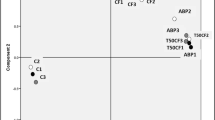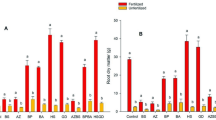Abstract
In the present study, effects of single, dual and triple combinations of phosphorus-solubilizing (Bacillus megatherium var. phosphaticum [M-13]) and N‑fixing bacteria (Stenotrophomonas maltophilia [82] and Ralstonia pickettii [73]) treatments were compared with chemical fertilizer and control treatments with regard to barley efficiency parameters. Efficiency parameters of dual bacteria inoculation treatments yielded closer outcomes to chemical fertilizers and as much as 69.9% N uptake efficiency, 92.5% N translocation efficiency, 70.7% N use efficiency, 87.9% agronomic efficiency, 87.4% physiological efficiency, 87.9% water use efficiencies for grain and 78.7% water use efficiency for biomass of chemical fertilizers (N + P recommended dose) were achieved with dual (73 + 82) bacteria treatments. Nitrogen-fixing dual bacteria treatment (73 + 82) was followed by triple bacteria combination (73 + 82 + M3). Combined bacteria treatments offered environmental friendly practices for soil enhancement and improved yield levels in organic barley farming. Therefore, combined bacterial applications (73 + 82 and 73 + 82 + M3) can be recommended as an alternative fertilization method in organic barley farming.
Similar content being viewed by others
References
AACC (1983) American Association of Cereal Chemists, Approved Methods of the AACC, 8th edn. The Association, St Paul (Method 46-12A, approved May 1969, revised October 1984)
Abbas ZH, Noni GB (2022) Effect of bacterial fertilizer on some characteristics of two cultivars of barley hordeum vulgare L. Nat. Volatiles Essent Oils 9(1):1393–1402
Agren GI, Wetterstedt JAM, Billberger MFK (2012) Nutrient limitation on terrestrial plant growth—modeling the interaction between nitrogen and phosphorus. New Phytol 194:953–960
Akköprü A, Özaktan H (2018) Identification of rhizobacteria that increase yield and plant tolerance against angular leaf spot disease in cucumber. Plant Prot Sci 54:67–73
Alaylar B, Güllüce M, Karadayı M, Koç TY, Karadayı G (2021) Rhizospheric PGPR strains of wheat, barley and trefoil grown in Ağrı province. Turkish J Nat Sci 10(2):182–190. https://doi.org/10.46810/tdfd.937841
Anderson WK (1985) Differences in response of winter cereal varieties to applied nitrogen in the field. II. Some factors associated with differences response. Field Crop Res 11:369–385
Anonymous (2005) Statistics of directorate of meteorology, Erzurum
Azadikhah M, Jamali F, Nooryazdan HR, Bayat F (2019) Growth promotion and yield enhancement of barley cultivars using ACC deaminase producing Pseudomonas fluorescens strains under salt stress. Span J Agric Res 17(1):e801. https://doi.org/10.5424/sjar/2019171-13828
Babier Y, Akköprü A (2020) Characterization of endophytic bacteria isolated from various cultivated plants and determination of their antagonistic effects on plant pathogenic bacteria. Yuzuncu Yıl Univ J Agric Sci 30(3):521–534
Bhardwaj D, Ansari MW, Sahoo RK, Tuteja N (2014) Biofertilizers function as key player in sustainable agriculture by improving soil fertility, plant tolerance and crop productivity Microb. Cell Fact 13:66
Bulut S (2013a) Evaluation of yield and quality parameters of phosphorous-solubilizing and N‑fixing bacteria inoculated in wheat (Triticum aestivum L.). Turk J Agric For 37(5):545–554
Bulut S (2013b) Evaluation of efficiency parameters of phosphorous-solubilizing and N‑fixing bacteria inoculations in wheat (Triticum aestivum L.). Turk J Agric For 37(6):734–743
Chouyia FE, Romano I, Fechtali T, Fagnano M, Fiorentino N, Visconti D, Idbella M, Ventorino V, Pepe O (2020) P‑Solubilizing streptomyces roseocinereus MS1B15 with multiple plant growth-promoting traits enhance barley development and regulate rhizosphere microbial population. Front Plant Sci 11:1137. https://doi.org/10.3389/fpls.2020.01137
Doyle AD, Holford ICR (1993) The uptake of nitrogen by wheat, its agronomic efficiency and their relationship to soil and fertilizer nitrogen. Aust J Agric Res 44:1245–1258
El-Beltagi HS, Ahmad I, Basit A et al (2022) Effect of Azospirillum and Azotobacter species on the performance of cherry tomato under different salinity levels. Gesunde Pflanz 74:487–499. https://doi.org/10.1007/s10343-022-00625-2
Emami S, Alikhani HA, Pourbabaei AA, Etesami H, Zadeh BM, Sarmadian F (2018) Improved growth and nutrient acquisition of wheat genotypes in phosphorus deficient soils by plant growth-promoting rhizospheric and endophytic bacteria. Soil Sci Plant Nutr 64(6):719–727. https://doi.org/10.1080/00380768.2018.1510284
Espidkar Z, Yarnia M, Ansari MH, Mirshekari B, Asadi Rahmani H (2017) Differences in nitrogen and phosphorus uptake and yield components between barley cultivars grown under arbuscular mycorrhizal fungus and pseudomonas strains Co-Inoculation in rainfed condition. Appl Ecol Environ Res 15(4):195–216
Etesami H, Alikhani HA, Hosseini HM (2015) Indole-3-acetic acid (IAA) production trait, a useful screening to select endophytic and rhizosphere competent bacteria for rice growth promoting agents. Methods X 2:72–78
Gang S, Sharma S, Saraf M, Buck M, Schumacher J (2021) Bacterial Indole-3-acetic acid influences soil nitrogen acquisition in barley and chickpea. Plants 10(4):780. https://doi.org/10.3390/plants10040780
Gomez-Macpherson H, Richards RA (1995) Effect of sowing time on yield and agronomic characteristics of wheat in South-eastern Australia. Aust J Agric Res 46:1381–1399
Gonzales Ponce R, Salas ML, Mason SC (1993) Nitrogen use efficiency by winter barley under different climatic conditions. J Plant Nutr 16:1249–1261. https://doi.org/10.1080/01904169309364610
Hafez M, Mohamed AE, Rashad M, Popov AI (2021) The efficiency of application of bacterial and humic preparations to enhance of wheat (Triticum aestivum L.) plant productivity in the arid regions of Egypt. Biotechnol Rep 29:e584
Ibanez A, Diez-Galan A, Cobos R, Calvo-Pena C, Barreiro C, Medina-Turienzo J, Sanchez-Garcia M, Coque JJR (2021) Using rhizosphere phosphate solubilizing bacteria to improve barley (Hordeum vulgare) plant productivity. Microorganisms 9:1619. https://doi.org/10.3390/microorganisms9081619
Jamily AS, Koyama Y, Win TA, Toyota K, Chikamatsu S, Shirai T, Yasuhara T (2019) Effects of inoculation with a commercial microbial inoculant Bacillus subtilis C‑3102 mixture on rice and barley growth and its possible mechanism in the plant growth stimulatory effect. J Plant Prot Res 59(2):193–205. https://doi.org/10.24425/jppr.2019.129284
Ju I (2018) A review: biofertilizer—A key player in enhancing soil fertility and crop productivity. J Microbiol Biotechnol Rep 2(1):22–28
Lin Y, Watts D, Kloepper J, Adesemoye A, Feng Y (2019) Effect of plant growth-promoting rhizobacteria at various nitrogen rates on Corn growth. Agric Sci 10:1542–1565. https://doi.org/10.4236/as.2019.1012114
Liu J, Wang Z, Chen Z, White JF, Malik K, Chen T, Li C (2022) Inoculation of barley (Hordeum vulgare) with the endophyte epichloë bromicola affects plant growth, and the microbial community in roots and rhizosphere soil. J Fungi 8:172. https://doi.org/10.3390/jof8020172
MSTAT‑C (1991) A software program for the design, management, and analysis of agronomic research experiments. Michigan State University, East Lansing
Naeem M, Mehboob N, Farooq M, Farooq S, Hussain S, Ali HM, Hussain M (2021) Impact of different barley-based cropping systems on soil physicochemical properties and barley growth under conventional and conservation tillage systems. Agronomy 11:8
Namli A, Mahmood A, Sevilir B, Özkir E (2017) Effect of phosphorus solubilizing bacteria on some soil properties, wheat yield and nutrient contents. Eurasian J Soil Sci 6(3):249–258
Pontes AP, Souza R, Granada CE, Passaglia LMP (2015) Screening of plant growth promoting bacteria associated with barley plants (Hordeum vulgare L.) cultivated in South Brazil. Biota Neotropica 15(2):e20140105. https://doi.org/10.1590/1676-06032015010514
Rashid MI, Mujawar LH, Shahzad T, Almeelbi T, Ismail IMI, Oves M (2016) Bacteria and fungi can contribute to nutrients bioavailability and aggregate formation in degraded soils. Microbiol Res 183:26–41
Raun WR, Johnson GV (1999) Improving nitrogen use efficiency for cereal production. Agron J 91(3):357–363
Salantur, A. (2003). Effects of bacteria strains isolated from cereal growing areas of Erzurum and Pasinler valleys on the growth and development of wheat and barley. PhD, Atatürk University, Erzurum, Turkey (in Turkish).
Shen J, Yuan L, Zhang J, Li H, Bai Z, Chen X, Zhang W, Zhang F (2011) Phosphorus dynamics: from soil to plant. Plant Physiol 156(3):997–1005
Singh RR, Prasad K (2011) Effect of bio-fertilizers on growth and productivity of wheat (Triticum aestivum). J Farm Sci 1(1):1–8
Singh A, Aggarwal N, Aulakh GS, Hundal R (2012) Ways to maximize the water use efficiency in field crops—Areview. Greener J Agric Sci 2:108–129
Singh B, Upadhyay AK, Al-Tawaha TW, Al-Tawaha AR, Sirajuddin SN (2020) Biofertilizer as a tool for soil fertility management in changing climate. IOP Conf Ser Earth Environ Sci 492:12158
Stanojković A, Ðukıć DA, Mandıć L, Pıvıć R, Stanojkovıć A, Jošıć D (2012) Evaluation of the chemical composition and yield of crops as influenced by bacterial and mineral fertilization. Romanian Biotech Let 17:7136–7144
Tahiri AI, Raklami A, Bechtaoui N, Anli M, Boutasknit A, Oufdou K, Meddich A (2022) Beneficial effects of plant growth promoting rhizobacteria, arbuscular mycorrhizal fungi and compost on lettuce (Lactuca sativa) growth under field conditions. Gesunde Pflanz 74:219–235. https://doi.org/10.1007/s10343-021-00604-z
Tang A, Haruna AO, Majid NMA, Jalloh MB (2020) Effects of selected functional bacteria on maize growth and nutrient use efficiency. Microorganisms 8(6):854–879. https://doi.org/10.3390/microorganisms8060854
TUIK (2021) Plant production data of Turkish statistics institute (TUIK). http://www.tuik.gov.tr. Accessed 04 June 2022
USDA (2021) The 2021 U.S. Agricultural Export Yearbook provides a statistical summary of U.S. agricultural commodity exports to the world and the United States’ primary trading partners. https://www.fas.usda.gov/data/2019-united-states-agricultural-export-yearbook Accessed 04 June 2022
Yagmur B, Gunes A (2021) Evaluation of the effects of plant growth promoting rhizobacteria (PGPR) on yield and quality parameters of tomato plants in organic agriculture by principal component analysis (PCA). Gesunde Pflanz 73:219–228. https://doi.org/10.1007/s10343-021-00543-9
Zaballa JI, Golluscio R, Ribaudo CM (2020) Effect of the phosphorus-solubilizing bacterium Enterobacter ludwigii on barley growth promotion. Am Sci Res J Eng Technol 63:144–157
Zhu Y, Wang Z, Wang J, Wang Z, Zhou J (2014) Plant growth-promoting rhizobacteria improve shoot morphology and photosynthesis in dryland spring wheat. Biomed Eng Environ Eng 145:343–350
Acknowledgements
Authors thank M. F. Donmez for providing the bacteria used in the research and applying the seeds (Faculty of Agriculture, Igdir University).
Funding
These data were obtained from the project supported by Atatürk University Research Fund (Project Number: BAP-2004/68).
Author information
Authors and Affiliations
Contributions
Özcan Çağlar: Project Administration and Supervision, Conceptualization, Methodology, Resources, Review. Sancar Bulut: Software, Formal analysis, Data Curation, Writing—original draft and Visualization & Editing.
Corresponding author
Ethics declarations
Conflict of interest
Ö. Çağlar and S. Bulut declare that they have no competing interests.
Ethical standards
This paper contains findings of an original research. Applicable national and/or international guidelines for animal ethics were followed and no animal was harmed during the study. Ethical standards were adhered in this study and in production of this manuscript.
Additional information
Consent for publication
The article submitted herein contains the findings of an original research, is not under consideration for publication elsewhere and is approved by all authors of this manuscript.
Rights and permissions
Springer Nature or its licensor holds exclusive rights to this article under a publishing agreement with the author(s) or other rightsholder(s); author self-archiving of the accepted manuscript version of this article is solely governed by the terms of such publishing agreement and applicable law.
About this article
Cite this article
Çağlar, Ö., Bulut, S. Determination of Efficiency Parameters of Barley Inoculated with Phosphorous-solubilizing and Nitrogen-fixing Bacteria. Gesunde Pflanzen 75, 1325–1333 (2023). https://doi.org/10.1007/s10343-022-00754-8
Received:
Accepted:
Published:
Issue Date:
DOI: https://doi.org/10.1007/s10343-022-00754-8




